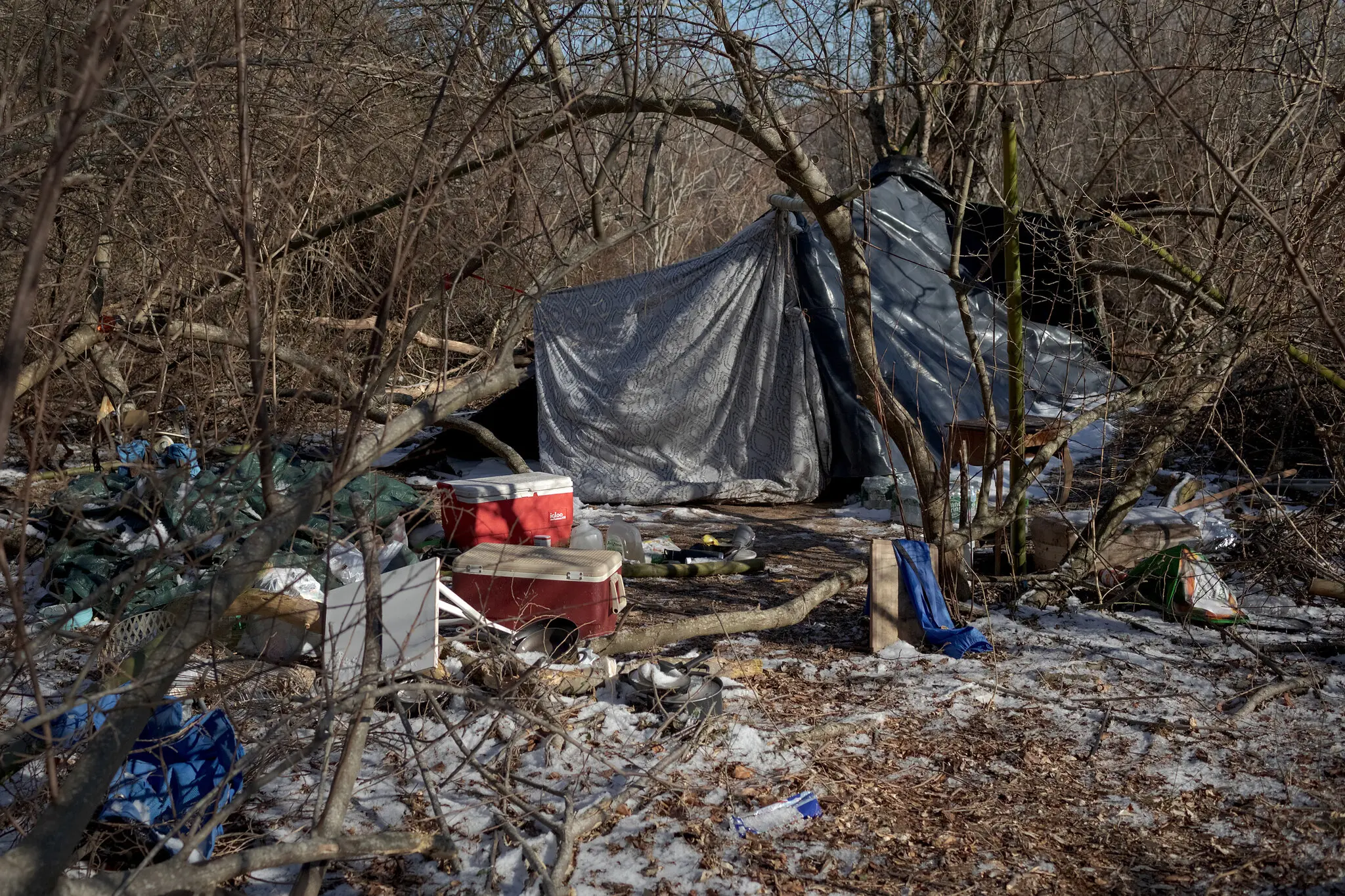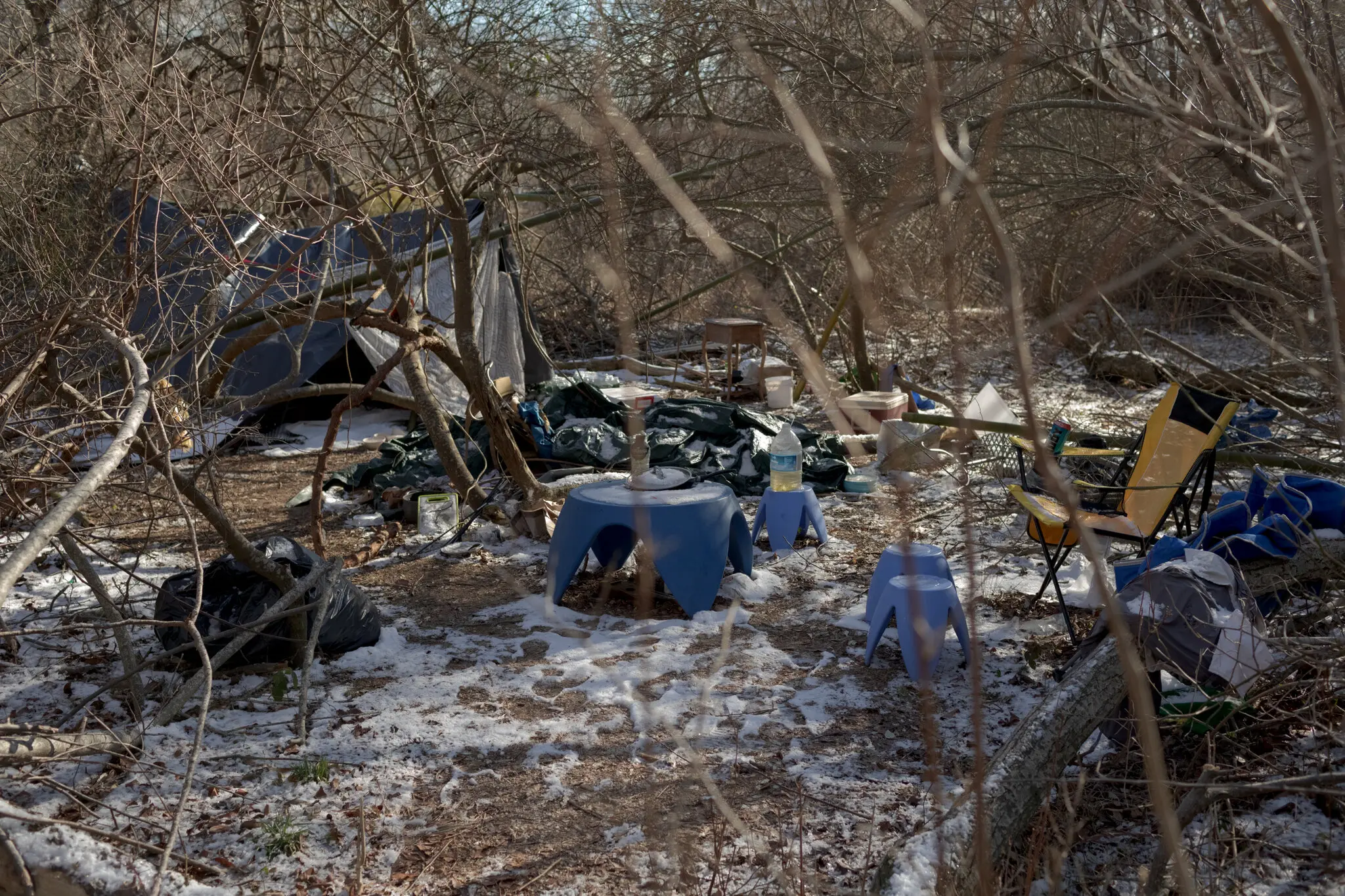
April 7, 2024 – Nytimes.com
Ginia Bellafante visited two encampments on Long Island’s East End on one of the coldest days of the year to see how day laborers survive winter outdoors.
Early in the evening of Dec. 30, Julio Florencio Teo Gomez, a carpenter from Guatemala City who had shifted around different living situations on Long Island for more than a decade, went looking for money he was owed for a job he had completed before the holidays. Like so many other day laborers operating in the far reaches of Long Island, he had found the work at a roundup one morning in the parking lot of the 7-Eleven in Southampton. Throughout the final week of the year, he visited the lot several times in the late afternoons, when painters and millworkers, handymen and others in the building trades are dropped off at the end of the workday. He hoped to find the contractor who had neglected to pay him and collect what he was due.
Whether he managed to get the cash is unclear, but at the end of his mission, Mr. Teo Gomez set out to visit his brother 17 miles away in Riverhead. Although they had been living together for a time, Mr. Teo Gomez’s home was now an encampment in the woods in Bridgehampton. It was shortly after 6 o’clock when he walked toward a bus stop on County Road 39, a stretch of road that runs from Shinnecock Hills to Water Mill and passes one of the country’s most exclusive golf clubs, a McDonald’s and the grave of Gary Cooper. Crossing in the dark, he was struck by a sedan. Police officers arrived and administered CPR. The driver remained at the scene of the accident and was not charged. Mr. Teo Gomez, who was 48 and had a wife and five children in Guatemala, died later that night at a nearby hospital.
For a good share of his adult life he had been part of a work force crucial to the high-season rituals of Long Island’s East End, where the upkeep of expensive property is meticulous and constant. The workers, who are for the most part undocumented immigrants from Guatemala and Mexico, are kept sufficiently busy during the stretch from April to September, when consistent landscaping work is available and they can make $100 to $150 a day — enough for a room in a house or apartment, or at least a designated sofa somewhere.
But the colder months — when there is no imperative to trim the hedgerows — demand alternatives. Some workers find them in the rhythms of the harvest, moving to the North Fork in October to pick grapes at local vineyards and then traveling to Florida to pick oranges during the winter. Others remain, and when they cannot afford a room, they live in the woods.
Encampments have emerged over the years as real estate values have soared and the least well-paid among the working class have had fewer options in terms of where and how they live. There is not a permanent homeless shelter in this part of Suffolk County. During the winter, the encampment population reaches about 100; it can double over the summer, when demand for workers — and the cost of rent — are so much higher.

The outdoor living arrangements are achievements in found-object design — mattresses positioned under jury-rigged tents, food prepared over an open fire or on propane cooktops. Water is hauled in gallon jugs, brought in from parks and convenience stores. But the encampment Mr. Teo Gomez lived in with two other men stands in such disorienting proximity to an Elle Decor evocation of the Hamptons that you can see the side of a Shingle-style house through the bare trees on a hill in the distance.
Homelessness in America
- L.A. Housing: More than a year into her term, Mayor Karen Bass of Los Angeles has cleared encampments and moved thousands of people into motels in a bid to prove that homelessness can be solved. What happens next is unclear.
- Chicago Referendum: Voters in Chicago rejected an increase to the city’s transfer tax on high-value properties, leaving unfulfilled a longtime goal of progressives who wanted to use new revenue to address homelessness.
- California’s Proposition 1: A key piece of the state’s strategy to address its homelessness crisis was narrowly approved by voters, in a stunningly close margin that had Democrats on edge for more than two weeks.
- Breaking a Cycle: Some homeless shelters are trying to help people find living arrangements with relatives or friends. It’s an acknowledgment that entering the shelter system can lead to a downward spiral.
Over the years, those who stay through the winter have benefited from the attentions of some local officials and charities and most recently from a trained social worker named Marit Molin, herself an immigrant from Sweden. When she and her family moved to the East End full-time from Manhattan nine years ago, she was struck by the way her children’s friends marveled at how much food she had in her fridge. As a summer resident, she’d had little sense of how many people struggled in such a lavishly wealthy place.
The children of housekeepers and other low-wage workers, she soon discovered, often spent summer days in the back of their parents’ cars, waiting for their shifts to end. Unsettled by the disparities, she started an art camp where 40 percent of children could attend for free. Two years later, in 2020, she founded Hamptons Community Outreach, with the goal of keeping people fed and helping financially strained homeowners make repairs they could not afford.
Ms. Molin first heard about the encampments three years ago when someone mentioned to her that there were people living outdoors and that occasionally they froze to death. She and an outreach team began regularly delivering food, often supplied by local restaurants she commandeered into service, as well as warm clothes, to the men living in them.

Poverty is not a new phenomenon on the South Fork, however incongruous that might seem within the context of $100-a-plate lobster salads. Neither are the efforts to alleviate it. In the early 1980s, a group in Southampton got together to figure out how to help those who could not make ends meet. Their effort grew into Heart of the Hamptons, a food pantry that provided more than 347,000 meals last year. In 2002 an organization called Maureen’s Haven, named after a nun of the Dominican order, arose to help men and women living on the fringes. Based in Riverhead, it provides shelter during the winter in roving locations, often in churches.
But in many cases, the offer of shelter is refused, as Gina Laferrera, detective sergeant at the Southampton Town Police, explained. People are put off by shelter rules — strict times of arrival and departure, baggage checks and a mandatory breathalyzer test. Among day laborers living in encampments, drinking is a means to stay warm and relieve the tedium of long days without any work.
Law enforcement tends to leave the encampments alone. The police will ask that they be taken down when they are erected on private property, Sergeant Laferrera said, but this rarely sparks conflict: “I can’t remember anyone ever resisting.”

Two weeks after Mr. Teo Gomez died, there was a memorial for him at a funeral home in Riverhead, which highlighted the close-knit nature of the day laborer community. About half of the 40 people who came lived in encampments. They arrived on a bus organized by Hamptons Community Outreach, which had raised thousands of dollars to cover expenses, through a post on Instagram. “Julio had big hopes and dreams, but life was not always easy,” Ms. Molin said in a brief eulogy. Others talked about their friend’s warmth and the sadness they now carried in his absence.

Genaro Garcia and Sergio Hernandez, the two men who had lived with Mr. Teo Gomez in the woods, stood in front of his coffin, which was open with white roses and hydrangeas beside it. Mr. Garcia had met Mr. Teo Gomez only a month before he died. He had become homeless after separating from his wife, and was sleeping behind a Kmart in Bridgehampton, where Mr. Teo Gomez discovered him and invited him to live in the encampment he and Mr. Hernandez had quietly built in the predawn hours last spring. They had used bamboo stalks cut from trees they found growing near the local train station to hold up tarps and create sleeping spaces. There was a cooking spot a few feet away and enough privacy that they remained off the radar.
During their time living together the three had grown close. At the funeral, the men wanted to honor their friend’s memory, but it was hard to speak, and they both broke down crying. “The help and advice he gave me will never leave my heart,” Mr. Hernandez, who has been in the United States for 18 years, said later.

Four days after the service, Ms. Molin visited the encampment, reached via a short walk into the woods on a relatively clear path. It was 20 degrees, and there was snow on the ground. Because the weather was so unforgiving, she offered to put the men up in a motel, as she had done for Christmas.
Ms. Molin has used scenes like this one — the encampment had papers and bottles scattered on the ground, a sheet functioning as a door to the tent — to try to raise awareness and money in the hope of delivering more aid. In a video she posted on Instagram in advance of a February charity event for her organization, she stands in front of a messy tent pitched between two trees and says, “Welcome to the Hamptons: A place where people live in mansions, and where they also live like this.” At the event, which raised $60,000, she announced plans for a job-training program that could help people find more lucrative work year-round. Even during the summer, the competition for landing day jobs is significant.
The housing crisis that has afflicted so much of the country has been especially severe in beach and ski towns where astronomical real-estate prices, driven even higher during the pandemic, and the low, fluctuating wages common to service work and often tainted by exploitative labor practices can make it almost impossible to find a living space.
In East Hampton, 78 percent of two-bedroom rentals are priced above $6,000 a month; the cheapest fall between $3,000 and $4,500. In Southampton, the figure seems even more unsustainable, with 85 percent of two-bedroom rentals exceeding $6,000 a month.

In recent years, there has been some movement to combat the shortage of housing for workers on the East End, replicating similar efforts in resort towns around the country. In November 2022, voters in East Hampton, Southhampton and Southold approved a proposal to levy a 0.5 percent tax on the sale of homes and property above $400,000, the proceeds of which would go into an affordable housing fund. But exactly where affordable housing should go breeds endless debate and litigation.
Another strategy currently being sorted out may hold more promise. In tandem with a developer and the town of East Hampton, Christopher Kelley, a lawyer who has served on many different community boards over three decades, is devising a plan that would require tweaking the zoning code to allow employers to build higher-density housing that could be leased to their own moderate- and low-income workers. The current code in East Hampton allows for only eight housing units per acre, but was written in 1984 to accommodate the limitations of sewer technology, which has since advanced.

One of Mr. Teo Gomez’s closest friends (an undocumented immigrant who asked to remain anonymous) was eventually able to attach himself to a single contractor and get regular work, which has allowed him to rent a room in Riverhead for $700 a month all year round. In the summer months, he can make about $800 a week, he explained through an interpreter, and is able to save some of it. When he and Mr. Teo Gomez got together, they talked about work and the ways that some employers had mistreated them: denying water on hot days, or hiring for two days of work and then demanding the job be completed in one.
In the view of his friends, Mr. Teo Gomez was the one to lift everyone up, to get them through these difficulties — to promise them that there would be better jobs, that some day there would be more money, new women, a reprieve from so much loneliness and isolation. It was not his ambition to remain on Long Island forever. His hope was to get back to Guatemala and build a house for his family. Sixteen days after he died, his body was flown home.
Anna Watts and Manuel Sosa contributed translation.




